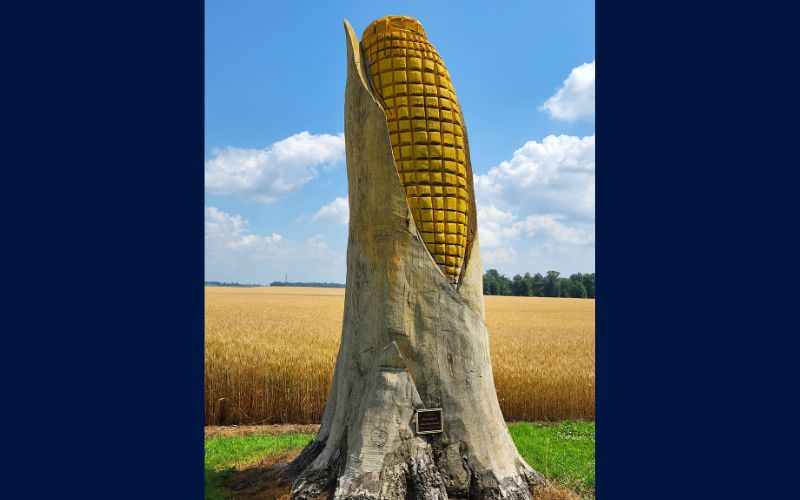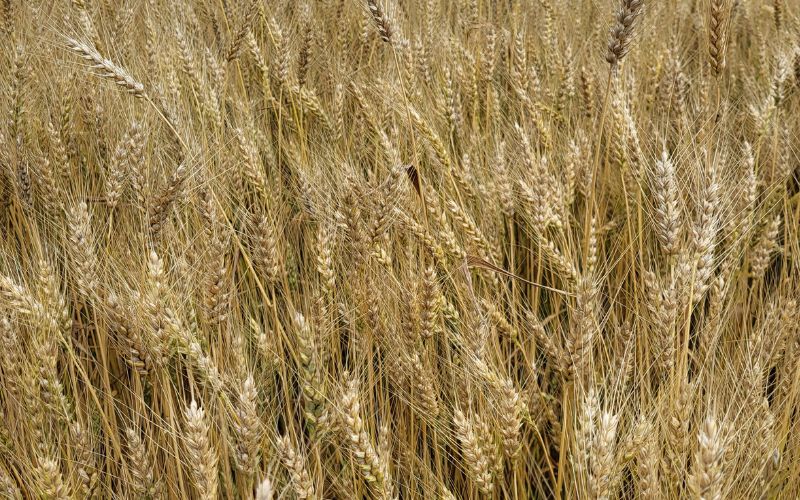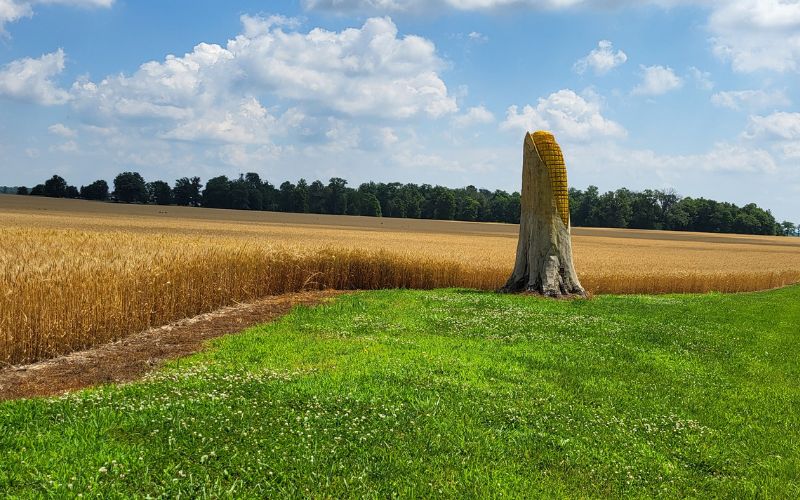By: Bernie Iven
Some amazing monuments to agriculture can be glimpsed from a car window. Cows, pecans, chickens, wheat, watermelons, pigs, and of course, corn.
One of the more famous is Dublin, Ohio’s “Field of Corn,” featuring 109 geometrically spaced ears of concrete corn.
It is designed, among other things, to mourn the loss of agriculture in the face of urban sprawl.
After all, the “field” is surrounded by concrete office buildings.
In August 2024, in the small Auglaize County township of Goshen, just northwest of Logan County, a decidedly more celebratory corn monument has been erected: the “Giant Ear of Corn”.
And it has been turning heads ever since.
Specifically, the sculpture is located in the fertile plain near the headwaters of the Scioto on State Route 385, about halfway between Roundhead and New Hampshire.
How did it get there?
Who commissioned it?
And why?
An inscription on the “Giant Ear of Corn gives a clue.
It reads, “In memory of Don Daley and John Manchester, Fathers, Neighbors, Friends.”
Nearby are stone entrance pillars with the sign, “Manchester Farm”.
I drove up the long gravel driveway to find some answers.
Caleb Wilson, a Bellefontaine resident and son-in-law of the farm’s owner, Tim Manchester, was happy to explain.
It seems that some years ago, a huge Red Oak that stood by the road on the edge of a Manchester field had begun to rot.
Presently, a windstorm toppled the weakened tree above 20 or so feet.
The limb debris was cleared out, but the tall “stump” was a bit of an eyesore.
Caleb and another employee of the farm, Josh, decided to turn the eyesore into a treasure.
That’s when they came up with the “Giant Ear of Corn” idea.
A sculpture, they thought, would emphasize the agricultural roots of the area.
Wheat or soybeans didn’t work with the stump’s shape.

The idea steeped for about a year, until Caleb came across a sign on State Route 68, just north of Bellefontaine near the railroad crossing.
The sign advertised the work of Chris Davis, a sculptor who works his magic primarily with chainsaws.
Chris was excited about the job but had done a few wooden sculptures rooted in the ground, or of such great size.
Fortunately, Caleb made the farm’s man-lift available to Chris, and in four or five days, the work was expertly finished.
Chris painted the corn kernels bright yellow and was going to do the husks green, but Caleb thought the brown grey of the natural wood better represented the color of corn husks at harvest time.
And the inscription?
Tim Manchester commissioned it to honor his father, John, and his friend and neighbor Don Daily, both of whom passed away a few decades ago.
And the Manchester Farm’s proud agricultural heritage stretches back more than a century and a half.
In 1858, Jason Manchester bought land in the area.

Later in 1908, his son, also Jason, in conjunction with famed Indiana barn builder Horace Duncan, created what barn-chronicler Robert Kroeger calls “The Magnificent Manchester”.
It is one of the most photographed barns in all of America.
And according to sources, it is the largest round barn east of the Mississippi.
Originally, the Manchester Barn was painted a reddish orange color with paint that, says Kroeger, was purchased at a huge discount from the Big Four Railway in Bellefontaine after a bankruptcy sale.
Years later, when new paint was needed, white was chosen because it was considered more prestigious.
But in 2008, for its centennial, the Manchester Barn was painted again in its original stunning colors.
The Manchesters, who represent a farming tradition of six generations, include the area’s new State Senator, Susan Manchester, who grew up on the farm.
Caleb says that several cars stop each day to photograph the “Giant Ear of Corn” and that at least a couple of cars a week stop to photograph the “Magnificent Manchester Barn”.
These two monuments to agriculture celebrate an industry that continues to thrive and grow in West Central Ohio.

















